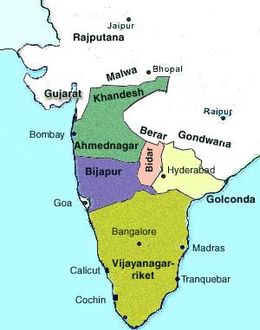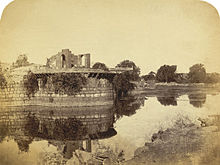- Melgiri Pandit
-
Melgiri Pandit (Devanagari: मेलगिरी पण्डित, Kannada: ಮೇಲ್ಗಿರಿ ಪಂಡಿತ್) was a Sardar that served under Emporer (Chhatrapati) Sambhaji of the Maratha Empire.[1] Sambhaji, the eldest son and successor to Emporer Shivaji, reigned from his father's death in 1681 to his execution at the hands of Aurangzeb in 1689.
A Brahmin Pandit hailing from the village of Melgiri near the Maharashtra-Karnataka border (in modern-day Solapur district),[2] Sardar Pandit is remembered for his military leadership during the War of 27 years, the longest recorded military engagement in the history of India.[3]
Most notably, Pandit successfully led the Maratha ground forces at Bijapur in 1685, pushing the Mughal forces under Emperor Aurangzeb back to their base camp at Ahmednagar. The following year (1686), Bijapur fell to Aurangzeb due to the surrender of Maratha ally Sultan Sikandar Adil Shah. However, these initial territorial losses were recovered and the War of 27 years was eventually won by the Maratha Empire in 1707.[4]
The descendants of Melgiri Pandit reside across North Karnataka, most concentrated in Dharwad District, Gadag District and Haveri District.
Contents
Background
Following the death of Shivaji in 1680, the Mughal Empire took the opportunity to launch a ground invasion of the Maratha Empire. This event marks the beginning of the War of 27 years.
In early 1681, Aurangzeb's eldest son, Prince Muhammad Mu'azzam (later crowned Bahadur Shah I), marched from the Mughal base at Ahmednagar with a 20,000-horse cavalry to lay siege to Bijapur. At that time, Bijapur was under the administration of Sikandar Adil Shah who had entrusted the task of defense to General Sarza Khan. Prince Mu'azzam wrote to General Khan to enlist his support against Sambhaji. The appeal for help went unheeded; Aurangzeb received clear proof of the alliance between Bijapur and the Maratha Empire.
In order to increase pressure on Sambhaji, a diversion against Bijapur was devised in January 1682. A detachment under Mughal General Ruhulla Khan was sent to attack the northern frontier of Bijapur and to check Maratha activities in the Parenda and Solapur regions. Another force was sent under Aurungzeb's second son, Prince Muhammad Azam Shah, to capture the fort of Dharvar (now Dharwad). After these initial successes, the Mughal campaign languished for many months when the prince was recalled in June 1683.
In 1684, the Mughals changed their Bijapur strategy. They established a number of outposts in the Bijapur territory in order to occupy the surrounding lands. However, the multiple fronts of the war made any serious action against Bijapur impossible due to resource constraints. On March 30, 1684, Sikandar Adil Shah received a letter from Aurangzeb demanding free passage for the Mughal army through the Bijapur territory and the expulsion of General Khan. In response, Sikandar Adil Shah sent a spirited reply refusing to accede to Mughal demands.
Though war was not officially declared, the increasing tension made military engagement imminent. Sikandar Adil Shah sent a letter to Golkonda beseeching aid from the Qutb Shahi dynasty and its allies.
The Siege of Bijapur
In early 1685, a promise of support arrived; the Maratha contingent dispatched by Sambhaji under General Melgiri Pandit arrived in Bijapur. On March 28, 1685, the Mughal army arrived within sight of Bijapur. On April 1, 1685, the siege of Bijapur began.
Mughal Generals Ruhulla Khan and Qasim Khan took strong positions on the northwestern side of the territory. As seen in the above map, the western edge of the territory was bordered by the ocean; the two other borders were blocked by heavily wooded mountain ranges (the Eastern Ghats and Satpura Range). The Marathas under Pandit flanked the open side and cut off the Mughal's supply lines. With their supplies cut, the Mughal forces had no other rations but indigenous coconuts and a poorly edible local grain called kudun. Great numbers of Mughal men and horses perished from famine.
When the wretched state of the Mughal army became known to Aurangzeb, he sent an order to the officers stationed at the port of Surat (in modern day Gujarat), directing them to ship as much grain as possible to the prince's detachment by sea. The Marathas intercepted this communication, and as the ships passed by their newly-erected fortresses, they raided most of them. The Mughal army retreated and fell back fighting all the way to Ahmednagar, where Aurangzeb was seated.
After this initial retreat, Aurangzeb shifted to Solapur on May 24, 1685 in order to be closer to the operating theatre. Prince Azam was given supreme command. The second Mughal advance on Bijapur was slower and more laborious. A garrison of 30,000 defended Bijapur Fort, while an equally strong army was dispatched to sever Mughal communications and raid Mughal territory.
For one year, the siege languidly continued. Allies began to flock to Sikandar Adil Shah. Multiple contingents arrived from Sambhaji, Siddi Masud Khan, and the Qutb Shahi dynasty of Golkonda. This open alliance signaled a rupture between the Mughal Empire and the Qutb Shahi dynasty. The Bijapur garrison also stiffened its attacks on the besiegers and inflicted heavy casualties. The Mughal position was further weakened by famine in the Mughal camp.
The Fall of Bijapur
Aurangzeb, in order to save his son Prince Muhammad Azam Shah from this sorry state of affairs, ordered a retreat. But the prince, whose spirit had been roused, refused to reduce himself to the level of his brother Prince Shah Alam who had returned from the Konkan campaign in shame. Prince Azam decided to carry on with the siege of Bijapur.
When Aurangzeb got news of the resolution of his son, he took steps to send relief and reinforcement. In spite of heavy attacks, reinforcements reached the Mughal camp under Ghazi ud-Din Khan Feroze Jung I. Mughal communications between Bijapur and Solapur were also restored. In October 1685, in retaliation for Golkonda's alliance with the Marathas, Prince Muazzam Shah Alam sacked the fort of Hyderabad (under Golkonda administration) and executed Madanna and Akkanna, the two senior Telugu Brahmin advisors to the Qutb Shahi dynasty of Golkonda.
With this upper hand, Aurangzeb then decided to take command of the siege operations himself. Leaving Solapur on June 14, 1686, he reached a suburb west of Bijapur Fort on July 3, 1686. The plight of the Mughal garrison was miserable. Scarcity raged resulting in the loss of men and cattle. On September 4, 1686, Aurangzeb rode in on horseback and inspired his men to attack the Bijapur Fort. But the initial attack failed due to the brisk return fire of the Bijapuris.
After eight days of intense fighting, Bijapur finally fell to the Mughals. This was not due to the success of the Mughal assault or the failure of the Maratha defenses. Sikandar Adil Shah and his officers decided to capitulate and opted to surrender Bijapur to avoid further bloodshed.
References
- ^ http://www.maharashtra.gov.in/pdf/gazeetter_reprint/Medieval/chapter_9.pdf
- ^ http://www.wikimapia.org/7654938/hi/Pandit-Koli-Melgiri-Farm-Anil-Golsar-Satara
- ^ http://www.maharashtra.gov.in/pdf/gazeetter_reprint/Medieval/chapter_9.pdf
- ^ http://www.maharashtra.gov.in/pdf/gazeetter_reprint/Medieval/chapter_9.pdf
Categories:
Wikimedia Foundation. 2010.


